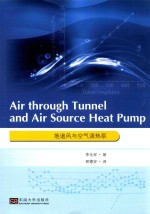图书介绍
地道风与空气源热泵研究PDF|Epub|txt|kindle电子书版本网盘下载

- 李永安著;邢德安译 著
- 出版社: 南京:东南大学出版社
- ISBN:9787564157142
- 出版时间:2015
- 标注页数:191页
- 文件大小:61MB
- 文件页数:200页
- 主题词:地道风-热泵系统-研究
PDF下载
下载说明
地道风与空气源热泵研究PDF格式电子书版下载
下载的文件为RAR压缩包。需要使用解压软件进行解压得到PDF格式图书。建议使用BT下载工具Free Download Manager进行下载,简称FDM(免费,没有广告,支持多平台)。本站资源全部打包为BT种子。所以需要使用专业的BT下载软件进行下载。如BitComet qBittorrent uTorrent等BT下载工具。迅雷目前由于本站不是热门资源。不推荐使用!后期资源热门了。安装了迅雷也可以迅雷进行下载!
(文件页数 要大于 标注页数,上中下等多册电子书除外)
注意:本站所有压缩包均有解压码: 点击下载压缩包解压工具
图书目录
Chapter 1 Introduction1
1.1 Current situation of energy source in China1
1.2 Utilization of renewable energy resource4
1.3 Traditional utility pattern of air through tunnel(hereafter referred to as“ATT”)6
Chapter 2 Characteristic of Formation Temperature Change9
2.1 Source of formation energy9
2.1.1 Solar radiation energy9
2.1.2 Biological heat10
2.1.3 Geothermal resources10
2.2 Thermo-physical property of formation soil10
2.2.1 Heat conductivity coefficient λ10
2.2.2 Specific heat cp11
2.2.3 Thermal diffusivity α11
2.3 Change rules of soil temperature inside formation13
2.4 Numerical mathematical model for original soil temperature field13
2.4.1 Dynamic model of shallow underground soil temperature distribution14
2.4.2 Solve the shallow formation soil temperature distribution in application of Fourier Law16
2.5 Characteristic analysis of formation temperature wave18
2.5.1 Formation soil temperature attenuating property18
2.5.2 Temperature wave delay20
2.5.3 Calculation of original formation soil temperature at the same time21
Chapter 3 Heat Transfer between Soil and Air in Tunnel23
3.1 Analysis of tunnel wall heat conduction process23
3.2 Introduction of coupling problem25
3.3 Selection of turbulence model29
3.4 Processing of near-wall region30
3.5 Mathematical description of the model31
3.6 Mesh generation of mathematical model32
3.7 Definition of boundary conditions in GAMBIT and FLUENT33
3.7.1 Settings for boundary conditions33
3.7.2 Preliminary defining of the types of boundary conditions in the GAMBIT36
3.7.3 Further defining the conditions of the mathematical model in FLUENT36
Chapter 4 Process Analysis of Air through Tunnel in Summer40
4.1 Determination of different parameters in simulation computation40
4.1.1 Air outdoor meteorological parameters40
4.1.2 Formation temperature41
4.1.3 Tunnel masonry material43
4.1.4 Convection heat transfer coefficient43
4.2 Analog computation and analysis of all factors for air cooling through tunnel44
4.2.1 Simulation computation and analysis for air cooling factors through tunnel under44
4.2.2 Dynamic simulation computation and analysis of air temperature drop through tunnel52
4.3 Tunnel cooling efficiency66
4.3.1 Effect of tunnel length on tunnel cooling efficiency67
4.3.2 Effect of tunnel buried depth on tunnel cooling efficiency68
4.3.3 Effect of tunnel wind speed on tunnel cooling efficiency70
4.3.4 Effect of tunnel structure size on tunnel cooling efficiency71
4.3.5 Effect of different ventilation time on tunnel cooling efficiency72
Chapter 5 State Change of Air through Tunnel in Winter75
5.1 Introduction of mathematical model75
5.1.1 Model zone setting76
5.1.2 Air outdoor meteorological parameters76
5.1.3 Formation temperature78
5.1.4 Soil physical property parameters79
5.1.5 Determination of convection heat transfer coefficient80
5.2 Simulation results81
5.3 Analog computation and analysis of all factors for air heating through tunnel84
5.3.1 Simulation computation and analysis for air heating factors through tunnel under steady state84
5.3.2 Dynamic simulation computation and analysis of air temperature drop through tunnel94
5.4 Tunnel heating efficiency105
5.4.1 Effect of tunnel length on tunnel heating efficiency106
5.4.2 Effect of tunnel buried depth on tunnel heating efficiency108
5.4.3 Effect of tunnel wind speed on tunnel heating efficiency109
5.4.4 Effect of tunnel structure size on heating efficiency110
Chapter 6 Air through Tunnel Experimental Study112
6.1 Experimental object description112
6.2 Experimental methods and apparatus114
6.2.1 Conditions preparation before the experiment114
6.2.2 Experimental methods and procedures114
6.2.3 Experimental apparatus116
6.3 Experimental error analysis118
6.3.1 Experimental apparatus error analysis119
6.3.2 Error analysis of experimental measurement119
6.4 Experimental procedures and data processing121
6.4.1 The experimental procedures and results of tunnel parameters measurement under original state121
6.4.2 Experimental procedures and results of each measured parameters inside the tunnel under ventilation state125
6.5 Comparative analysis of experimental results and theoretical calculation131
Chapter 7 ASHP136
7.1 Heat pump and its type136
7.2 Air source heat pump(ASHP)137
7.3 The characteristics of ASHP140
7.4 The applicability of ASHP143
Chapter 8 Air Source Heat Pump Based on Air through Tunnel150
8.1 Air source heat pump based on air through tunnel150
8.2 Introduction of ASHP experimental system based on air through tunnel152
8.2.1 Work principle of ASHP system based on ATT152
8.2.2 Experiment facility and test method153
8.3 Experiment data and analysis of ASHP based on ATT157
8.4 Frostless ASHP based on ATT162
8.5 Application analysis of ASHP based on ATT164
8.6 Innovation analysis of ASHP based on ATT168
Annex173
Annex 1 Surface Temperature,Temperature Wave Amplitude,and Maximum Depth of Frozen Ground of Main Cities in China173
Annex 2 Calculating Parameter for Building Material Thermo Physical Characteristic181